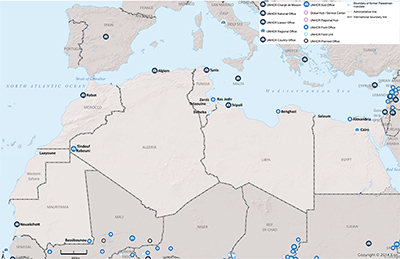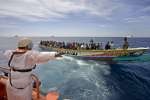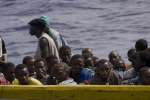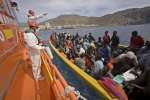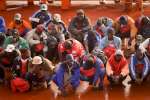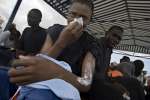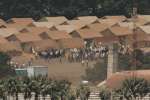Home > Where We Work > Middle East and North Africa > North Africa > Western Sahara Territory
2015 UNHCR subregional operations profile - North Africa
| Overview |
The North Africa subregion remains either a transit or final destination for sizeable mixed migration flows from sub-Saharan Africa. The instability still affecting some parts of the subregion, in particular Libya, continues to generate irregular movements to Europe. Since the start of 2014, UNHCR offices throughout North Africa have witnessed an increase in the number of asylum-seekers.
The ongoing unrest in some countries has created greater protection needs, with increased numbers of refugees and asylum-seekers being arrested and detained, particularly those from sub-Saharan Africa. Terrorist activity in the Sahel and Sinai regions, as well as fighting between rival militia in Libya, have also affected UNHCR's operations, reducing access to asylum.
The key challenge facing UNHCR in North Africa continues to be the arrival of asylum-seekers where regional countries are unstable and witnessing a period of transition. This is exacerbated by the absence of national and regional strategies for managing mixed migration movements, and the lack of national asylum systems consistent with international standards.
Local integration also remains a challenge in the subregion, while the prospects for voluntary repatriation for most refugee groups in the region are limited. The main durable solution for the most vulnerable continues to be resettlement.
The profile of people of concern to UNHCR in countries in the North Africa subregion is not expected to change significantly in 2015, with the exception of Libya, where the location of some people of concern is unknown following recent unrest in the country.
Other than the refugees in camps in Algeria and Mauritania (see below), most refugees and asylum-seekers in North Africa reside in urban areas. UNHCR has registered 155,000 Syrians who have sought refuge in the North Africa subregion, approximately 140,000 of whom are in Egypt. Another 50,000 non-Syrian refugees registered with UNHCR are also living in urban situations.
However, UNHCR's urban programmes in the countries of the region are relatively small, with limited capacity to assist the growing numbers of refugees and asylum-seekers. These populations face difficult socio-economic challenges, as they lack legal status and work permits. The Office helps them gain access to housing, basic social services and opportunities to become self-reliant.
An increasing number of asylum-seekers from South Sudan and Sudan have been registered by UNHCR in Egypt. The Office has also reached an agreement with the Egyptian authorities on the transfer of several hundred refugees and asylum-seekers from Salloum Camp (near the Egyptian-Libyan border) to Cairo, pending departure for resettlement or other durable solutions.
Fighting in Libya in mid-2014 prompted the organization to share a contingency plan with respective authorities in Egypt and Tunisia, and to implement emergency preparedness measures, in particular in southern Tunisia.
In 2015, UNHCR will continue to support building the capacity of local authorities in countries such as Algeria and Morocco as they establish national asylum infrastructure. Once the laws are adopted by national structures, the Office will provide training, conduct workshops and facilitate professional exchanges.
There are some 50,000 Malian refugees at Mauritania's Mbera Camp, near the Mali border. Movements into the country and spontaneous returns have stabilized. Biometric registration recently completed by UNHCR and the Government has enhanced the protection afforded to this group, by allowing the organization to optimize its interventions. Hopes are rising for a political breakthrough that re-establishes peace in Mali and prompts the start of a repatriation programme. In 2015, close attention will be given to the likelihood of voluntary returns to Mali, while tailoring an appropriate UNHCR response.
The Sahrawi refugees in Algeria are settled in five camps near Tindouf. Owing to the remoteness of the area, they remain dependent on humanitarian assistance with little prospect of self-reliance as income-generating activities are scarce. The Government estimates that there are 165,000 refugees in the camps. Pending a registration exercise, UNHCR's assistance programme will continue to be based on a planning figure of 90,000 vulnerable Sahrawi refugees. The Confidence Building Measures (CBM) programme for these refugees will continue in 2015, in an effort to meet the humanitarian needs of families who have been separated for a prolonged period of time. These measures will also help reduce the psychological isolation of the refugees, by restoring family and community links. The CBM activities complement the efforts of the United Nations to find a political solution to this protracted refugee situation. More than 20,000 people have benefitted from the CBM programme's family visits. In total, 48,000 people have registered for the programme since its 2004 inception, and further expansion will continue in 2015, in addition to cultural seminars.
Fragile security and instability in Egypt make addressing the needs of people of concern more challenging. Worryingly, this has also stretched public tolerance for the growing number of Syrians arriving in the country. The Office will continue to advocate for maintaining this protection space in 2015.
| Response and implementation |
UNHCR's operations in Algeria, Egypt and Mauritania are covered in separate chapters.
UNHCR will continue to focus on safeguarding and expanding protection space; establishing responsive national asylum systems; and promoting protection-sensitive management of mixed migratory movements.
The organization will seek to expand partnerships with States, governmental and non-governmental organizations (NGOs) and civil society, to develop fair and efficient legislative and administrative frameworks for asylum. The Office's strategic priorities remain: delivering life-saving assistance; ensuring protection for all people of concern; seeking durable solutions, including resettlement as a protection tool; and preparing for new emergencies.
In Libya, with the eruption of fighting between rival militia, large numbers of refugees and asylum-seekers are taking the risk of crossing the Mediterranean with people smugglers. So far in 2014, more than 110,000 such people have arrived on Italian shores, of whom half originate from the Syrian Arab Republic (Syria) and Eritrea. UNHCR will intensify efforts to address such mixed-migration phenomena in a comprehensive manner, working with Governments, IOM and NGOs.
The eruption of civil conflict across the main urban centres in Libya in 2014 led to the evacuation of all international presence and the suspension of UNHCR activities. In 2015, depending on the security situation and the re-establishment of access to populations of concern, UNHCR will seek support for its activities from the national authorities and other partners in the country. It will visit and provide assistance to people of concern in detention and advocate for alternatives to incarceration. UNHCR will also strengthen registration, ensure that adequate protection mechanisms are in place, provide capacity-building workshops for government officials, and reinforce the pursuit of durable solutions.
In Morocco, the development and establishment of a national asylum system continues. The Ad-hoc Committee, of which UNHCR is a member, has reviewed several hundred cases and regularized the situation of 835 people of concern, in accordance with international legal standards. UNHCR will continue supporting government institutions and civil society as they enhance their capacity to manage asylum requests.
Pending the adoption of an asylum law in Tunisia, a priority for UNHCR will be to maintain sufficient capacity to conduct refugee status determination while building national capacities to assure international protection of refugees and asylum-seekers. In 2015, the Office will assist the Government of Tunisia in adopting and setting up a comprehensive national protection system; this would allow the authorities to progressively assume their responsibilities under the 1951 Refugee Convention.
UNHCR will also work to ensure that refugees are granted access to public services in Tunisia. Accordingly, supporting local structures and organizations will be essential to provide protection and assistance, in particular for refugees and asylum-seekers with special needs. In the predominantly urban context, the organization will implement a community-based protection approach, with the support of relevant national and international actors.
| Financial information |
In the North Africa subregion, UNHCR's financial requirements increased significantly in 2012 in the aftermath of the Arab Spring and the subsequent spread of conflict, including in Mali. The Syria crisis is having a significant impact on operations in North Africa, while repatriation of Malian refugees from Mauritania is still hampered by insecurity in the northern part of Mali.
Since 2012, total requirements for the subregion have stabilized and are set at USD 180.4 million for 2015, almost entirely allocated to the refugee programme.
| UNHCR 2015 budgets for North Africa (USD) | ||||
|---|---|---|---|---|
| Operation | 2014 Revised budget (as of 30 June 2014) |
2015 | ||
| Refugee programme PILLAR 1 |
IDP projects PILLAR 4 |
Total | ||
| Total | 194,519,094 | 178,950,799 | 1,450,833 | 180,401,632 |
| Algeria | 32,708,250 | 33,227,036 | 0 | 33,227,036 |
| Egypt Regional Office | 99,014,244 | 85,170,372 | 0 | 85,170,372 |
| Libya | 19,722,146 | 18,212,314 | 1,450,833 | 19,663,147 |
| Mauritania | 23,990,818 | 24,368,374 | 0 | 24,368,374 |
| Morocco | 3,588,701 | 3,516,919 | 0 | 3,516,919 |
| Tunisia | 6,006,778 | 6,394,560 | 0 | 6,394,560 |
| Western Sahara (Confidence Building Measures) | 8,838,157 | 7,213,152 | 0 | 7,213,152 |
| Regional activities | 650,000 | 848,071 | 0 | 848,071 |
Source: UNHCR Global Appeal 2015 Update
UNHCR contact information
| Head of Operations | |||||||||||||||
|---|---|---|---|---|---|---|---|---|---|---|---|---|---|---|---|
| Style of Address | Head of Operations | ||||||||||||||
| Street Address | UNHCR/CBM Western Sahara, Villa 04 - Quartier Moulay Rachid, 165, Rue Al Zaraktouni, BP-755, Laayoune, Western Sahara | ||||||||||||||
| Mailing Address | P.O. Box 755, 70000 Laayoune, Western Sahara | ||||||||||||||
| Telephone | 212 52 88 92 369 | ||||||||||||||
| Facsimile | 212 52 88 93 097 | ||||||||||||||
| wshla@unhcr.org | |||||||||||||||
| Time Zone | GMT + 0 | ||||||||||||||
| Working Hours |
|
||||||||||||||
| Public Holidays | 01 January 2015, New Year's Day 05 January 2015, Mawlid al-Nabi 03 April 2015, Good Friday 01 May 2015, Labour Day 15 July 2015, Eid Al-Fitr 30 July 2015, National Day 22 September 2015, Eid Al-Adha 23 September 2015, Eid Al-Adha 18 November 2015, National Day 25 December 2015, Christmas Day |
||||||||||||||
| Comments | Holidays 2015 Thursday, 01 January New Years Day Friday, 02 January Mawlid al-Nabi Friday, 03 April Good Friday Friday, 01 May Labor day Wednesday, 15 July Eid-al-Fitr Thursday, 30 July National day Tuesday, 22 September Edi -al- Adha Wednesday, 23 September (in lieu of UN day) Wednesday, 18 November National day Friday, 25 December Christmas day | ||||||||||||||

